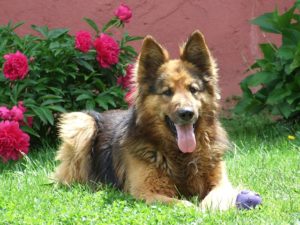
Gardening is a relaxing hobby. It’s just the earth, your plants, and you, outside enjoying the sunshine and all of the goodness that nature has to bring, unless you have dogs or cats, in which case all of that quietude and peace is interrupted regularly, sometimes delightfully and sometimes less so. That lovely bed of mulch you so painstakingly raked into soft piles around your flowers is now a perfect litter box, or so Kitty thinks. And the snowball bush in the corner, doesn’t it have the word “ball” in it? Can you really blame Spot for digging it up and dragging it around the yard? Well, yes, you can. So what’s the pet solution?
Dogs in Your Garden
One of the main problems with dogs in the garden is the digging issue. Dogs are dogs, and dogs like to dig. So here are some solutions that deal with that problem and a few others:
- One solution is to use temporary fencing until the plants mature. For a small dog breed, you can use a 16-inch fence border. Just place it around the border of the garden and it will discourage the dog from tromping all over your new plants. Or if your dog is of the larger variety, you can encase your veggies in a chicken wire cage with a top enclosure. As an added bonus, this keeps out rabbits and deer, too! Another option is to use wooden plant stakes placed diagonally through the root balls of the new plants to keep them in place. Weed mat is not a good idea, though, because once it’s shredded by an enthusiastic Fido, it’s a real mess to clean up and replace.
- You can also use bitter stuff on your beds to keep dogs from eating your plants. A simple and inexpensive solution is to spray plants with white vinegar, or a more potent mixture of bitter orange oil and coffee grounds can be used. Just spread it around your plants to make it unpleasant to dig and snuffle.
- Create trails for your dog around the perimeter of your yard or garden bed. Don’t use material that would heat up in the sun and burn the dog’s paws, though, like stone or gravel. Also, provide shaded areas, mulched areas, and grassy places for the dog to lie on. Always have fresh water available to keep your canine pal happy and healthy.
- To keep your lawn from becoming urine-spotted, run the hose over any spots your dog has urinated on to dilute the urine. You can also rake up any dead patches and then add lime mixed with seed and compost to repair the damage in the bare spots.
Cats in Your Garden
The needs of cats are fairly simple: Create safe spots to lounge away from dogs, roosters, or dominant hens, and give them a place for play and relaxation. Cats don’t cause as many problems in the garden as dogs, but there are some issues. They do tend to use the garden mulch as a litter box, and they catch wild birds, which is detrimental to their already-dwindling numbers. What’s a gardener to do?
- To deter your cat from using the mulch as an outdoor outhouse, use bigger wood chips where you can. You can also lay down chicken wire on top of the garden bed before planting. If you plant seed crops like lettuce and peas, they’ll grow right through it, and the wire can be cut to accommodate larger plants. Since cats can’t “scratch and cover,” they won’t go there for relief, and the fencing will sink into the soil pretty quickly so you won’t see it, but the cat can still feel it.
- You can also spread grapefruit and orange rinds throughout your beds. A lot of people swear that the citrus scent will repel cats. Mine certainly avoid it!
- “Scaredy Cat” and “Dog’s Gone” are two types of coleus that are said to drive cats and dogs out of garden beds. The plants are available in nurseries or garden centers or online.
- To protect the birds, place a belled collar around your cat’s neck. Also, make sure there aren’t bushes or tall grasses too close to the feeders for the cat to hide in.
Gardening in harmony with your pet brings both of you joy and is well worth the time and ingenuity it takes.
 Genevieve Schmidt is a professional landscape designer and the writer behind www.NorthCoastGardening.com. She has written for Fine Gardening, Garden Design, and many other prestigious publications. Appointed in 2010 to the Design Review Commission of Arcata, CA, she reviews landscaping plans for commercial and historic properties in her city. You can follow her on Twitter @NcoastGardening.
Genevieve Schmidt is a professional landscape designer and the writer behind www.NorthCoastGardening.com. She has written for Fine Gardening, Garden Design, and many other prestigious publications. Appointed in 2010 to the Design Review Commission of Arcata, CA, she reviews landscaping plans for commercial and historic properties in her city. You can follow her on Twitter @NcoastGardening.
